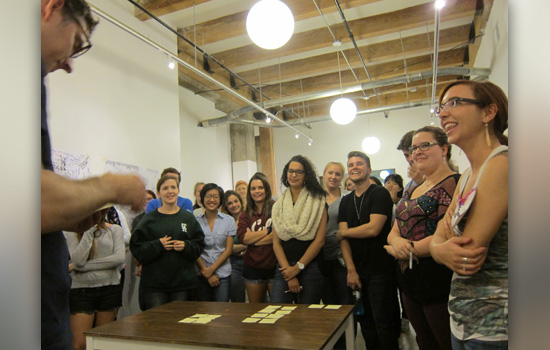Project pushes students to ‘think wrong, do right’
Project M ‘design blitz’ gets students to challenge status quo when addressing today’s issues
Kelly M. Murdoch-Kitt
Guest facilitator and RIT alumnus Ryan Clifford, left, reveals pairs of random words, which each interdisciplinary team had to use toward creating their final concepts. RIT students, from left to right: Veronica Brown, Isar Chang, Kayla Rakower, Leah Hall, Liah Perez, Abbey Smith, Brendan Babiarz, Lori Meyer, Janette Heininger.
A recent multidisciplinary and collaborative experience encouraged students from Rochester Institute of Technology’s School of Design to challenge the status quo when it comes to addressing the serious challenges facing communities today.
The brainchild of graphic designer John Bielenberg, “Project M” has taken place in cities around the world since it was founded in 2003 as an intensive, immersion program meant to inspire designers, writers, filmmakers and photographers to use their work to positively impact communities.
RIT hosted a two-day Project M “design blitz” during which 38 third- and fourth-year students representing all five disciplines of the School of Design in the College of Imaging Arts and Sciences (CIAS) had to rapidly research issues and challenges that create a disconnect between the RIT suburban campus and the city of Rochester, and propose solutions that were presented as videos to introduce their concepts. The project was sponsored by the CIAS Dean’s Office, School of Design and Roberts Communications. The two-day event was held at the Rochester Brainery in the city’s Village Gate.
“The theme refers to the disconnect between RIT students in the suburbs and the wonders and challenges of the city of Rochester, and how students can contribute their talents and skills to help solve social problems,” said Lorrie Frear, an associate professor of graphic design who coordinated the event. “The energy throughout the ‘blitz’ was amazing, and this was by far the most successful student event I have witnessed in my 25 years of teaching at RIT.”
More than 70 students from the school’s industrial design, graphic design, interior design, new media design and 3D digital design programs submitted application videos to participate in the project. Students initially submitted application videos in which they highlighted social problems that concerned them. Jurors then selected 40 applicants to participate in the blitz.
Students met at the Rochester Brainery, where Bielenberg and Ryan Clifford—a graphic design major who graduated from RIT in 2000 and coordinates the blitz events—delivered project details compelling participants to come up with ideas on how to bridge the gap between RIT’s suburban campus and the city of Rochester.
Cross-disciplinary student teams then spent an hour walking around the city, where they had to find five people and five stories to bring back to the group. They also conducted a series of exercises to further explore their thinking, perceptions and experiences in the city.
“By the end of the first day, student teams had solid directions for their projects,” Frear said. “The second day was devoted to compiling research and creating two-minute videos and digital presentations to reinforce their concepts to a wider audience.”
Both Bielenberg and Clifford were impressed with the ideas and execution presented by RIT students.
“Unlike other school assignments, the blitz is completely driven by participants—so the success and learning potential depends entirely on the energy, passion and commitment of the student teams,” Bielenberg said. “The RIT group had an unprecedented collective enthusiasm from beginning to end. It would be fantastic to see something like this built into the curriculum.”
Clifford added that “overall, there was a really inspiring sense of enthusiasm, matched by really fun, interesting personalities” among the RIT students.
“The students worked really effectively as teams and collaborators, but there was also a really fun social component to the experience,” said Clifford, a former adjunct and visiting professor in RIT’s graphic design program. “John and I are already hearing about teams that have continued to work together, and students that are now involved in incorporating methodologies from the blitz weekend into their design studios at RIT.
“I’d love to see them use the experience as a springboard for community building within the design school, as well as continue to work together to make a positive impact on campus,” Clifford added. “They were on fire during the blitz, and I’d love to see that momentum continue.”
A number of RIT design students who participated in the project plan to do just that.
“Project M gave me whole new set of questions to ask myself as a designer,” said Joe Hodapp, a third-year graphic design major from Louisville, Ky. “Hopefully it will open the doors to further interdisciplinary interaction between creative fields—and possibly the more technical ones. It can only serve to benefit us as a school and a society.”
Leah Hall, a third-year graphic design student from Pittsburgh, met Rochester native and former NFL tight end Roland Williams during her research for the blitz. Since retiring from football, Williams has focused much of his time working with children.
“Roland has a charity named Champion Academy, and after meeting with him during the blitz, I am now a member of his design team,” Hall said. “I will be working with him to promote the charity. I am still in disbelief that this has happened.”
“Within those 48 hours I had changed as a designer. I was able to work on a project and receive an amazing opportunity all at once,” Hall added.
Frear noted that Project M was a success for everyone involved.
“All of the cross-disciplinary teams succeeded in delivering unique, creative and meaningful concepts to bridge the gowns (campus) and the town (Rochester),” Frear said. “We hope this is the first of many such adventures, and that these design pioneers will follow through in realizing their amazing ideas.”













